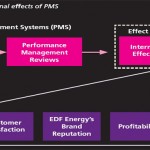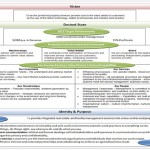Performance Prism at a glance
Performance management systems (PMS) represent information-based routines and procedures formally expressed that managers use to maintain or alter patterns in organizational activities (Simons, 2000). More and more organizations are implementing new and alternative performance management systems in order to obtain better results. These systems focus on reproducing financial and non-financial information that is relevant for decision making and managerial action. Some of the better known performance management systems are the Balanced Scorecard and the Performance Prism.The Performance Prism sets out to be a holistic performance measurement framework (Neely, Adams & Kennerley, 2002). It addresses the key business issues, asking critical questions for decision makers to think through the links between the indicators used (Neely, Adams & Crowe, 2001).
Being a three dimensional model, in five perspectives, it addresses all of an organization’s major stakeholder groups:
- Investors;
- Customers & intermediaries;
- Suppliers;
- Regulators;
- Communities.
A key principle behind the Performance Prism is to have a limited number of indicators in order to give clarity to what the organization is trying to achieve (Centre for Business Performance, Cranfield School of Management, 2009).
The five facets of the Performance Prism
• Stakeholder Satisfaction (Who are the key stakeholders and what do they want and need?)
• Strategies (What critical processes do we require if we are to execute these strategies?)
• Processes (What capabilities do we need to operate and enhance these processes?)
• Capabilities (What contributions do we require from our stakeholders if we are to maintain and develop these capabilities?)
• Stakeholder Contribution (What strategies do we have to put in place to satisfy the wants and needs of these key stakeholders?)
Origins
The Performance Prism measurement framework has been developed in close co-operation by the Centre for Business Performance at Cranfield School of Management (formerly at University of Cambridge) and the Process Excellence Core Capability Group of Andersen Consulting.
Implementation
Seen by its authors as a comprehensive measurement framework, the Performance Prism was designed to assist performance indicators selection – the vital process of picking the right measures from a different perspective than that of other performance frameworks such as the better known Balanced Scorecard (Neely, Adams & Crowe, 2001). Thus it looks first at the needs of the major organisational stakeholder groups and secondly it analyses the best strategies that need to be employed to satisfy those needs.
Performance Prism vs. Balanced Scorecard
Oftentimes the Performance Prism is compared with Balanced Scorecard (BSC), as it is considered to present solutions to the limitations of the BSC.
By addressing stakeholder value, rather than shareholder value, the Performance Prism aims to minimize the key flaw of the Balanced Scorecard (Smith, 2005). Also, it allows to link external performances expected by stakeholders with internal performances of the organisation. Moreover, having the measures aligned with cross-functional “end to end” processes is considered to be a valuable advantage for Performance Prism (Ducq & Kromm, 2009).
Further reading – Case studies:
- Anderson, W. (2007), Speaking the Language of Management: Applying the Performance Prism to Public Relations Assessment, Vol. 15, No. 2, pp. 120-130.
- Centre for Business Performance, Cranfield School of Management, (2009), A literature review of performance management and measurement
- Ducq, Y. & Kromm, H. (2009), Design and implementation of performance measurement system in an international surfwear company, in 6th International Conference on Theory and Practice in Performance Measurement and Management, New Zealand.
References:
- Centre for Business Performance, Cranfield School of Management, (2009), A literature review of performance management and measurement, available at: http://www.idea.gov.uk/idk/aio/306299 (accessed 12 December 2010)
- de Waal, A.A. (2003), THE ROLE OF BEHAVIORAL FACTORS IN THE SUCCESSFUL IMPLEMENTATION AND USE OF PERFORMANCE MANAGEMENT SYSTEMS, Management Decision, Vol. 41, No. 8, pp.668-697.
- Ducq, Y. & Kromm, H. (2009), Design and implementation of performance measurement system in an international surfwear company, in 6th International Conference on Theory and Practice in Performance Measurement and Management, New Zealand.
- Neely, A., Adams, C. & Kennerley, M. (2002), The Performance Prism: The Scorecard for Measuring and Managing Business Success, Financial Times Prentice Hall , Great Britain.
- Neely, A., Adams, C. & Crowe, P. (2001), The performance prism in practice, Measuring Business Excellence, Vol. 5, No. 2, pp.6-12.
- Simons, R. (2000), Performance Measurement and Control Systems for Implementing Strategy: Text and Cases, Prentice Hall, Upper Saddle River, NJ.
- Smith, M. (2005), Performance measurement & management: a strategic approach to management, SAGE Publications Inc.
- Neely, Adams & Crowe, (2001)

Tags: Andy Neely, Performance Management, Performance Prism, Scorecard






